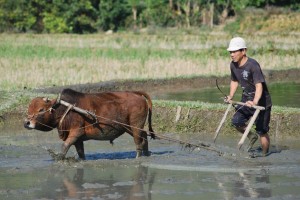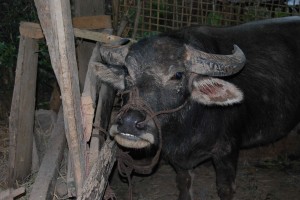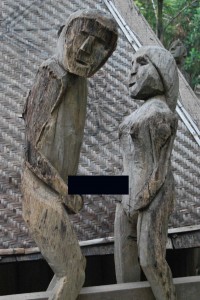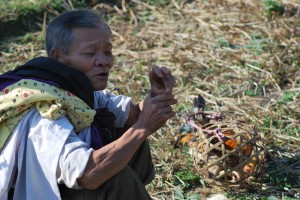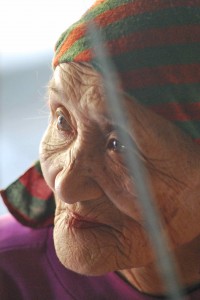Hien, Education and Tradition
January 18, 2012
We are all enjoying our guide Hien, our guide for this trip. I think she is enjoying us.
She is 24 and a recent college graduate. Her parents are farmers outside of Hanoi who live in a traditional Viet home. This means that her parents had a bedroom and everyone else slept in the one other room, which was used for worshiping, eating and sleeping. For most of her life, she shared a bed with her grandfather while her sister shared a bed with their grandmother. According to Hien, many grandparents decide that once they have grandchildren, they no longer “had to sleep with each other.”
I think this is very odd that a 50 year-old would rather sleep with a granddaughter than his or her spouse, but that seems to be the way of things.
She has told us stories about her time on the farm. For years, they did not own a water buffalo to help with plowing
, so she and her mother were tethered to the plow and her father ran the plow: “we played cow!”. The idea of this tiny woman and her mom acting as substitutes for a draught animal blows my mind.
She still lives in her family home and is the primary wage earner. An English-speaking tour guide for a top travel company makes much better money than farmers. Some years ago before she became a tour guide, the family had a disagreement as to whether or not to buy a refrigerator. Apparently the concern was that there would be no money left over to put food in the fridge.
She is also very excited to teach and to learn. We have exchanged ideas on everything from economics to culture to politics.
When she teaches us, she is a big fan of asking questions to prime our minds. It is actually a proven teaching technique. If I want to teach you a historical date, you are more likely to learn it if I first ask you to guess the date and then tell you, rather than just telling you the first time.
At dinner, she will point to a dish and ask, “What meat do you think that is?” or “Can you guess the vegetable?” She will not tell you after just one guess. Sometimes, we have to guess 4 or 5 times.
Here is a bit of a sampling:
- While driving to the village where we will have a homestay: “How many kilometers do you think the children in this village need to travel to get to their school each day?” The answer is 9 – but “now they have bikes, much better than walking!”
- Pointing to a musical instrument in the Museum of Ethnology: “What is that instrument made of?” I guessed “some type of gourd” she corrected me and said pumpkin. I think pumpkin is a type of gourd, but I might be missing a subtlety here.
- She showed us this picture of a man carrying fishing baskets on his bike.
She then asked “How many baskets do you think he is carrying? Please know, some of the baskets are small.” The answer? 800!!!
- While visiting the Single Column Pagoda in the Ho Chi Minh museum area: “What does that look like to you?” This one was tough. We said “pagoda?” No. “Spirit house?” No again. We made a few more guesses before she said “It looks like a lotus flower.” I do not think that it looked like a lotus flower at all. This was less of a fact than an opinion, but I am not so foolish to argue with a confident tour guide. [Note: guides are told to always provide an answer and never to say “I don’t know”. Since I am descended from wise people who were quick to admit ignorance, I find false answers given with certainty a little hard to deal with.]
- While looking at the barn animals of our homestay: “How many teeth do you think the water buffalo has on her top row?”
Answer is zero, but the amusement comes as children got close enough to learn this truth.
- My favorite came at the Museum of Ethnology. We were visiting actual architectural structures of different ethnic groups. Some were homes, others community houses. We came to one low building that was no more than 6 feet high at the peak. It was surrounded with roughly 30 3-foot-high carvings. These carvings fell into three categories. One was single people contemplating something. Others were pregnant women. The final group featured men who were – um – excited. The people who made the sculpture clearly had an inflated opinion of themselves.
As we approached the structure, she asked, “what do you think this building is for?” The obvious answer (“to embarrass the Texans”) seemed like a bad answer. Susie and I then came to the same conclusion. It was a wedding structure or a fertility shrine. Nope. This is a tomb. This particular tribe believed that every death resulted in a new birth. Thus death and fertility were intertwined.
We have also learned a great deal about being Vietnamese in general and being a Vietnamese woman in particular. She is the first woman in her village to attend university. When she was born, her father yelled at her mother for providing a second daughter and not a son. This is a sad story to start with, but is particularly sad given the fact that the newborn girl was a breach birth and came out blue.
Hien is also wonderful about engaging the people we meet.
We encountered a man that had a rooster and burning reeds who was chanting. After a talk with Hien, we learned that he is essentially a medicine man who was chanting to the spirits to return health to a local elderly person.
We talked with a man in the market who sold some of the most vicious-looking rat traps I have ever seen. He took great delight in demonstrating their operation.
The best visit was with a woman who lived above a loom. She was 86 years old.
She had married at age 15 (our boys’ age), but her husband died 5 years later in 1946 of a disease. She stayed with his family and raised her children. She had lived as a widow in the same home for 66 years. We met her granddaughter and her two great granddaughters. They invited us into their home for tea.
During this gathering, several odd things happened. First, the little ones took great delight in popping out from behind furniture and scaring us.
Second, we learned about the requirements of a young woman before she can get married. Around the age of 13, young girls start weaving. They do so because they must complete 40 pillows, 20 cushions and 12 blankets before they are considered mature enough for marriage. In essence, the girls would knit their dowry. We actually sat on the floor on cushions she had fashioned in the late 1930s as she earned her right to wed.
[Note: once engaged, the date is set by the local fortune-teller. One of Hien’s cousins consulted the soothsayer and learned that her most auspicious date would be 2 weeks later!! “It was pretty disorganized, but you must respect tradition.”]
Third, they proudly shared a remarkable blanket.
This stunning piece took three years to weave and is over 25 feet long. It is the blanket that will adorn her coffin that her granddaughter made for her. They talked about the inevitable funeral with a matter-of-fact aspect that struck me as really healthy. They do not fear death as the ultimate enemy, but see it instead as part of the process of life.
Finally, we got a surprise. As the granddaughter poured the tea, the great-grandmother emerged with a water bottle and plopped it on the floor near us. She was smiling. The red of the betel chew accentuated her smile. I looked at Hien.
“Happy water.” After my confused gaze, she explained, “this is rice liquor they made themselves. It is a great honor to share some with them.”
They laid out enough glasses for Susie, Hien, me, the 86 year-old and her granddaughter with one glass to spare. I soon learned that this was not, in fact, how this tradition would transpire. Our great grandmother went back for more glasses. The six glasses she brought were all for the Baskins. Hien drinks very little, but she quickly explains that it is very rude to refuse this gift of hospitality.
So, my children had their first shot of alcohol from an 86 year-old master-weaving widow during a traditional tea ceremony in a remote mountain in Vietnam. I alternate between thinking that we are giving our children fantastic experiences and calling Child Protective Services to turn myself in.
Steve Sir
